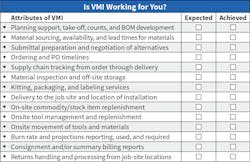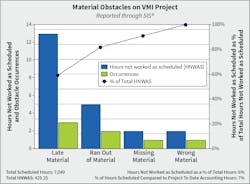The Benefits of Vendor-Managed Inventory on Job Sites
Let’s start this discussion by defining VMI. The simple translation is VMI stands for vendor managed inventory — but what does that mean, and how should that help you? Using the services of vendors to do more than drop ship material on your doorstep has been a topic of many research projects/articles and, more importantly, a focus area for many supply chain efficiency improvements and vendor partnerships in recent years. VMI can consist of any service provided by the vendor that either manages your inventory for you or reduces the effort, burden, and risk of you managing your inventory.
For this discussion, we will focus on managing or reducing the risk associated with material needs on your projects. Therefore, VMI is any or all of the services provided by your vendor intended to aid you in achieving the result of having the correct material at the location where it is needed, when it is needed, packaged and labeled for efficient manipulation or installation, and defect-free. Plus, we can add the benefit of minimizing the effort and cost to handle and manage returns.
Collecting data
The results of various VMI applications vary widely among different relationships, and this has a lot to do with how information and expectations are shared between the contractor and the vendor. To determine how much is too much — or how much is not enough — requires a simple means of evaluation or answering the question. Is VMI benefiting your project? What is provided here is a simple tool to guide you through a self-assessment of your project’s VMI application and the results. Although this is simple, there are two stages involved. First, let’s address what your VMI actually looks like, and second, let’s look at how effective your VMI is in the way you currently have it implemented.
For each of the attributes listed in Fig. 1, identify whether you and your vendor have agreed that they will provide that service, and then whether you believe that your vendor is providing that service. In this quick assessment, you can see whether you have what you expect or whether your expectations are built around a model that you don’t have.
For the assessment tool in Fig. 1, there is no scoring; it’s simply to allow you and your vendor to review your expectations and work to implement the services/solutions that you’ve agreed upon. Once you have that in place — and you know that you are using VMI as expected — then you are ready to advance to the question of whether it is benefiting you. The benefit is gauged by reference to the original intent of VMI and whether you are meeting the objectives. We use vendor services and VMI to reduce our risk of failing to have the correct material at the correct location for installation at the correct time for installation and in a condition that it is easily identifiable and ready for manipulation or installation. As with any benefit analysis, this requires data and a reference.
As a reference, you can either collect data before and after implementation of the VMI (reference is the prior baseline performance), or you can measure the performance of the VMI job to that of a similar non-VMI reference job. In both cases, the larger the reference sample (more jobs or more time), the better your results will be. The least accurate (but often used) reference is perception. In each of the measurable areas, do you subjectively believe that your results are better than they would be without the use of the VMI? For contractors utilizing WEM® Software (including JPAC® and SIS®), there is no need to collect additional data or complete further analysis, as these tools already provide the qualified and quantified benefit of VMI relative to planned productivity expectations on VMI and non-VMI jobs.
Analyzing VMI data
Once the data collection is complete, the analysis of the data will require assessing the labor hours spent to correct the errors that are not caught by the vendor and to perform the expected and needed tasks not performed by the vendor. The total cost of this time is a running and repeatable job cost or cost savings (after subtracting any fees paid to the vendor for their VMI services). For contractors using WEM Software, including DCI Construction®, the combined and direct productivity impact and cost benefit of VMI can be directly visible using JPAC and SIS as data collection tools and the analysis capability of DCI Construction for the financial impacts.
For one contractor, material-related obstacles account for 8% of its total hours not worked as scheduled company-wide. On a project where they implemented VMI, material barriers were cut in half, amounting to only 4% of the total hours not worked as scheduled. Using SIS, the contractor was able to evaluate the implementation of VMI and monitor any issues with deliveries, material quantities, or communications with the vendor, as shown in Fig. 2.
Additional considerations regarding the benefit of VMI include the availability of labor to perform these tasks. If the vendor did not perform these tasks, who will? Do you have enough available manpower to take on this work, or is having the vendor provide the services beneficial? Yet another consideration is the impact of delays and liquidated damages (LDs) if submittal dates and PO dates miss the required lead times. There is a greater risk of missing these dates if they are not being tracked and monitored within the supply chain.
The result of many VMI project analyses suggests that the VMI benefit is positive and worthwhile when the vendor is adequately engaged and responsible for material management and movement, but only if they are also included in the planning and early ordering activities. VMI does not eliminate lead time; it only reduces the risk of adverse results from missing the lead time requirements and material related installation delays.
For more information on MCA’s research, visit the company’s website at www.mca.net.
Phil Nimmo is vice president of business development at MCA, Inc. at MCA, Inc., Grand Blanc, Mich. He can be reached at [email protected]. Sydney Parvin is an associate data analyst at MCA, Inc., Grand Blanc, Mich. She can be reached at [email protected].
About the Author
Sydney Parvin
Sydney Parvin is associate data analyst at MCA, Inc., Grand Blanc, Mich. She can be reached at [email protected].
Phil Nimmo, MCA, Inc.
Phil Nimmo is vice president of business development at MCA, Inc. He can be reached at [email protected].


